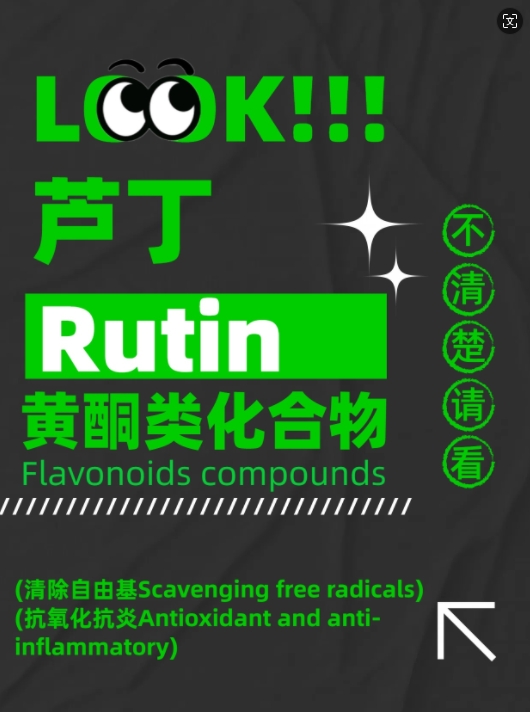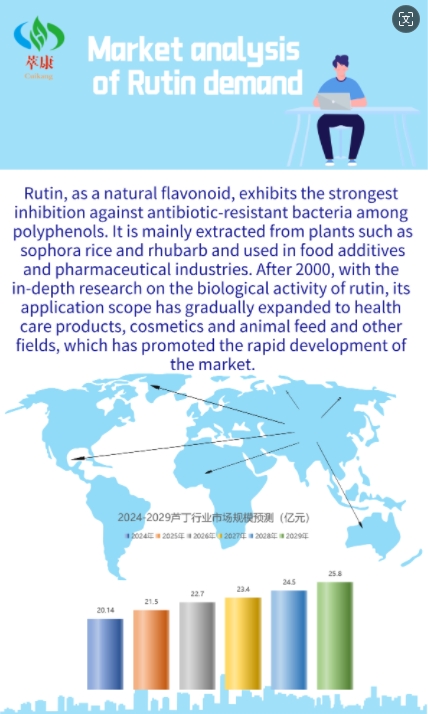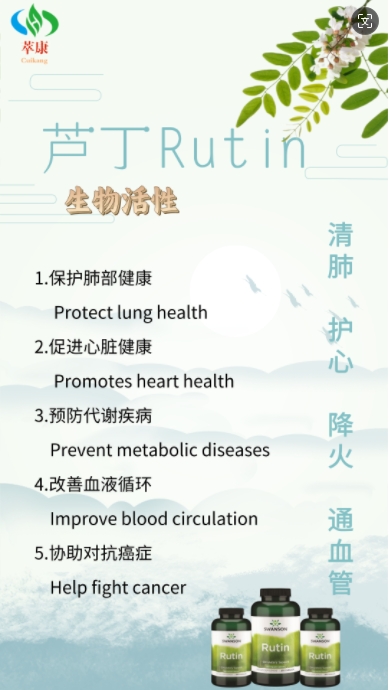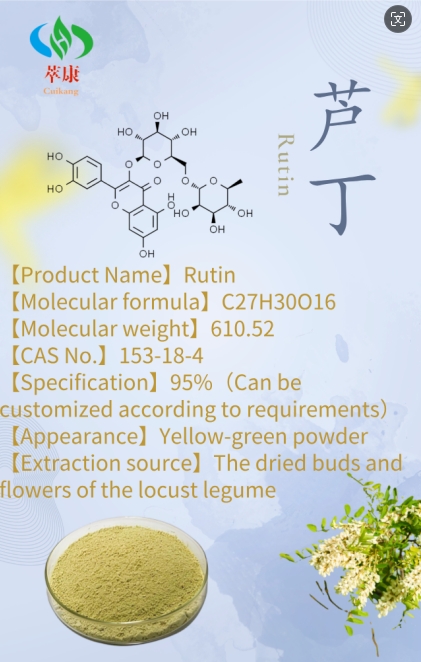Rutin is a flavonol compound quercetin rutin, which is a kind of flavonoid compound extracted from plants. It exists in rutin, Tartary buckwheat, locust tree bud, sorbus leaf, tomato stem, leaf and seed shell, etc. About 3% of dried buckwheat when it is about to bloom, jujube, hawthorn, ginkgo biloba, Chinese medlar, mother wort, bupleurum, summer hay, aloe vera, and giblet. The content of SophorajaponicaL in the flower bud of Sophora japonical can reach more than 20%, which is the main raw material for extracting rutin in Chinese pharmaceutical industry. Rutin can be decomposed by adding water in case of strong acidity and alkalinity. It is unstable in color in alkaline foods and has antioxidant capacity. Ethanol can improve the light resistance of the pigment preparation, prevent the gradual disappearance or change of fragrance, and can improve its antioxidant capacity when combined with vitamin E. The inhibitory effect of rutin on lipid peroxidation is related to the enhancement of SOD activity and the promotion of oxygen free radical scavenging. Sophora rice has a strong antioxidant effect on edible oil. The free radical scavenging rate of acacia rice extract can reach 40% ~ 70%, which can be used as a new edible oil and fatty food additive with health function, and can also be used in cold drinks, beverages, pastries, meat processed products and aquatic processed products. Tartary buckwheat rutin health factor has the effect of lowering blood lipid, blood pressure, urine sugar and weight loss, and has been developed into a delicious and convenient snack (Tartary buckwheat tea, Tartary buckwheat rice, Tartary buckwheat noodles, etc.). Rutin was hydrolyzed with 2% dilute H2SO4 for 1h, cooled, precipitated in filter set, washed and dried, and refined quercetin was obtained by recrystallization with ethanol. If other flavonoids such as quercetin are mixed with alpha-tocopherols, or catechins, the additive effect can be shown.
Properties: It has the effect of reducing capillary permeability and brittleness, maintaining and restoring the normal elasticity of capillary. It is used for prevention and treatment of cerebral hemorrhage, hypertension, diabetes, retinal hemorrhage, purpura and acute hemorrhagic nephritis. It has a good anti-radiation and anti-free radical effect on the skin, and has a strong absorption effect on ultraviolet rays and X-rays. As a natural sunscreen, adding 10% rutin can increase the absorption rate of ultraviolet rays to 98%. It has obvious scavenging effect of reactive oxygen species.
Source: Plant Ruta RutagraveolensL. Whole grass essential oil, locust ScphorajaponicaL, leguminous plant. The main component of the fruit (sophora hornwort), HypericumaseyronL. The light of the whole grass, rat Li Kezhi branches hook catechu BerchemiapolyphyllaWall, varleiocladaHand. - Mazz., euphorbiaceae plants wild wutong MallotusjaponicusMuell. - Arg, leaves, Buckwheat FagopyrumesculentumMoench polygonaceae plants seedlings.
▶ Main pharmacological effects and related applications
1. Food coloring (like lemon yellow); Antioxidants; A nutritional supplement. Mainly used in cold drinks, beverages, pastries, meat products, aquatic products and so on.
2. Vitamins. It has the effect of reducing capillary permeability and brittleness, maintaining and restoring the normal elasticity of capillary. It is used for the prevention and treatment of hypertensive cerebral hemorrhage, diabetic retinal hemorrhage and hemorrhagic purpura, and is also used as a food antioxidant and pigment.
It has anti-inflammatory effect; Vitamin P-like effect, can maintain the resistance of blood vessels, reduce its permeability, reduce brittleness and so on, has the lipid removal effect on the liver with fat infiltration, and the combination of glutathione has more obvious lipid removal effect; Antiviral action and inhibiting aldose reductase action.

In the fast-paced modern life, health has become an irreplaceable precious treasure for each of us, however, many diseases quietly invade, often because of the lack of timely detection and qualitative, thus becoming difficult to control. Rutin, as a natural flavonoid, exhibits the strongest inhibition against antibiotic-resistant bacteria among polyphenols. Originally extracted mainly from plants such as sophora rice and rhubarb, it was used in the food additive and pharmaceutical industries, especially in the field of cardiovascular disease prevention. Since the 1990s, China's rutin market has experienced a significant growth stage. After 2000, with the in-depth research on the biological activity of rutin, its application scope has gradually expanded to health care products, cosmetics and animal feed, which has promoted the rapid development of the market. The market of rutin will maintain steady growth in the next few years, and the market size forecast of China's rutin industry from 2024 to 2029 (for reference only, does not represent the actual data) :

At present, there are mainly the following product addition directions on the market:
▶ Pharmaceutical Industry
For the prevention and treatment of hypertensive cerebral hemorrhage, diabetic retinal hemorrhage and hemorrhagic purpura. Rutin can maintain the resistance of blood vessels, reduce the permeability and brittleness of blood vessels, and has the effect of removing fat in the liver infiltrated by fat, and the effect of combining with glutathione is more obvious. Antiviral action and inhibiting aldose reductase action.
▶ Health care products
Anti-inflammatory, antiviral, antioxidant, etc
▶ Cosmetics
It has antioxidant properties and can be used in cosmetics with antioxidant properties
▶ Food
Food coloring (like lemon yellow); Antioxidants; A nutritional supplement. Mainly used in cold drinks, beverages, pastries, meat products, aquatic products and so on

English name】Rutin
【CAS】153-18-4
【Molecular formula】C27H30O16
【Molecular weight】610.52
【Extraction source】Dried buds and flowers of Sophora legume
【Product Specification】Rutin 95%
【Detection method】UV
【Appearance】 yellow-green powder
